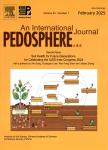版权所有:内蒙古大学图书馆 技术提供:维普资讯• 智图
内蒙古自治区呼和浩特市赛罕区大学西街235号 邮编: 010021

作者机构:State Key Laboratory of Pollution Control and Resource Reuse School of the Environment Nanjing University Nanjing210093 (China) Nanjing Institute of Environmental Sciences State Environmental Protection Administration Nanjing 210042 (China) Department of Biology Anhui Institute of Education Hefei 230061 (China)
出 版 物:《Pedosphere》 (土壤圈(英文版))
年 卷 期:2008年第18卷第3期
页 面:344-352页
核心收录:
学科分类:083002[工学-环境工程] 0830[工学-环境科学与工程(可授工学、理学、农学学位)] 07[理学] 08[工学] 09[农学] 0903[农学-农业资源与环境] 0713[理学-生态学]
基 金:the PhD Fund of the National Education Ministry of China (No20030284038) the Interna-tional Foundation for Science (NoW/4215)
主 题:environmental assessment fuzzy mathematical model heavy metal pollution pollution index method soil
摘 要:Four assessment methods (two pollution indexes and two fuzzy mathematical models) were employed to investigate the environmental quality of four soils around a ferroalloy plant in Nanjing City. Environmental quality was assessed as class Ⅳ (moderately polluted) for each soil with single-factor index method, and was identified to be classes Ⅳ, Ⅲ (slightly polluted), Ⅲ, and Ⅲ for soils A, B, C, and D, respectively, with the comprehensive index model. In comparison with the single-factor index method, the comprehensive index model concerned both dominant parameter and average contribution of all factors to the integrated environmental quality. Using the two fuzzy mathematical methods (single-factor deciding and weighted average models), the environmental risks were determined to be classes Ⅳ, Ⅲ, Ⅱ (clean), and Ⅱ for soils A, B, C, and D, respectively. However, divergence of the membership degree to each pollution class still occurred between the two methods. In fuzzy mathematical methods, membership functions were used to describe the limits between different pollution degrees, and different weights were allocated for the factors according to pollution contribution. Introduction of membership degree and weight of each factor to fuzzy mathematical models made the methods more reasonable in the field of environmental risk assessment.